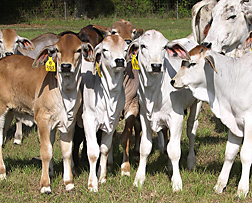Tenderizing Tough Brahmans
The Brahman is a sturdy cattle breed and well adapted to life in the subtropics. It can cope well with poor-quality forage as a food source and with exposure to parasites, diseases, and weather extremes. This has enhanced the breed’s ability to withstand hot and humid weather and the hordes of insects infesting western Florida and other Gulf Coast states.
Brahman crossbred cows perform well in the southern United States, so they are widely used there. But Brahman purebred and crossbred cattle are not known for consistently producing tender, tasty beef. The question is, do all Brahman cattle produce tough meat, or is there sufficient variation within the breed to make them more acceptable?
To answer that question, a scientific team led by animal scientist Chad Chase and animal geneticist David Riley at ARS’s Subtropical Agricultural Research Station in Brooksville, Florida, developed a set of expected progeny differences, or EPDs, for the Brahman breed.
EPDs have been used for years by cattle breeders to estimate the genetic value of a parent animal for a variety of production traits. Differences in EPDs between two individuals of the same breed can predict differences in their future offspring’s performance, when each is mated to animals of the same average genetic merit.
The work done by Riley and Chase, along with Don Franke, a professor at the Animal Science Department at Louisiana State University, and Joe Paschal, a livestock specialist stationed at the Texas A&M Research and Extension Center in Corpus Christi, is the first to produce EPDs for carcass traits of Brahman cattle.
Using progeny records from 230 Brahman sires and more than 1,700 Brahman carcasses from Louisiana, Texas, and Florida, the scientists showed that indeed there is variability in carcass traits among Brahman sires. Genetic control for some traits such as marbling and yield was high, indicating that good progress could be made selecting for those traits. Genetic control for tenderness was lower, suggesting that a combination of selection and processing techniques may be more beneficial. The other traits measured were 12th rib fat thickness, hot carcass weight, and rib eye area.
Having EPDs for Brahman cattle will permit breeders to differentiate among sires and select those that will improve carcass quality and meat palatability. This may eventually enhance the marketability of purebred and crossbred Brahman calves.
“These carcass and tenderness EPDs are evidence that U.S. Brahman breeders are serious about addressing end-product issues in their cattle,” says Riley. “This data will definitely benefit those who breed Brahmans,” adds Chase.—By Alfredo Flores, Agricultural Research Service Information Staff.
This research is part of Food Animal Production, an ARS National Program (#101) described on the World Wide Web at www.nps.ars.usda.gov.
Chadwick C. Chase and David G. Riley are with the USDA-ARS Subtropical Agricultural Research Station, 22271 Chinsegut Hill Rd., Brooksville, FL 34601; phone (352) 796-3385, fax (352) 796-2930.
"Tenderizing Tough Brahmans" was published in the September 2006 issue of Agricultural Research magazine.







